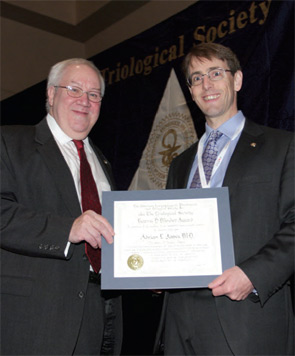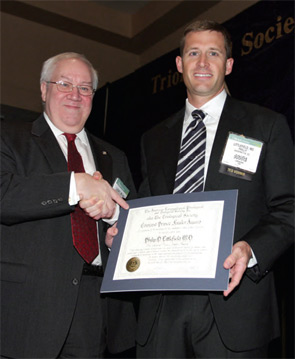LAS VEGAS—A test that measures in real time how a noise stimulus on one side affects contralateral otoacoustic emissions (OAEs) could be a new, more accurate predictor of hearing in newborns, according to award-winning research presented at the Annual Meeting of the Triological Society, part of the Combined Otolaryngology Spring Meetings held here April 28-May 2.
Explore This Issue
June 2010Contralateral suppression, or the medial olivocochlear (MOC) reflex, could also be used to assess the effects on hearing of neonatal disorders like hyperbilirubinemia, said Adrian James, MD, a pediatric otorhinolaryngologist at the Hospital for Sick Children in Toronto.
Dr. James won the Mosher Award at the Triological Society’s meeting for his work. In another research highlight, the society gave the Fowler Award to Philip Littlefield, MD, a neurotologist at the Walter Reed Army Medical Center, for his work on laser stimulation of auditory nerve fibers, which shows the potential to boost the quality of help for the hearing impaired. That research was done at Northwestern University in Chicago under the mentorship of Claus Peter-Richter MD, PhD.

Mosher Award
In Dr. James’ work, testing contralateral suppression was a better predictor of hearing outcomes in hyperbilirubinemia-affected infants than the standard auditory brainstem response (ABR) test. In contralateral suppression, a noise stimulus in one ear causes a signal to pass along the cochlear nerve across the brainstem to the other side, where it has the effect of reducing otoacoustic emissions.
It is known that in certain forms of auditory neuropathy, this reflex is lost. But Dr. James thought that conditions with more variable severity might have a varied effect on the reflex. The test is done by giving a sound stimulus, then detecting OAEs with digital filtering, which gives a continuous readout of the response.
In unsedated infants with normal hearing who were tested in the noisy neonatal intensive care unit (NICU), all had a detectable contralateral suppression response. “This demonstrated that it’s a feasible test even in the acoustically inhospitable environment of the NICU,” Dr. James said.
In infants with hyperbilirubinemia, the OAE levels dipped down within the same amount of time as those without, but it took longer for OAEs to come back up after the stimulus stopped. “It’s quite plausible that the brainstem is where hyperbilirubinemia is affecting the pathway, although further work would have to be done to substantiate this hypothesis,” Dr. James said.
Researchers took a closer look at five infants with auditory neuropathy spectrum disorder (ANSD) to see how well the contralateral suppression response could predict hearing.
All of the infants failed the ABR test, but three of them still had intact contralateral suppression. The researchers discovered on follow-up that all the infants with a contralateral suppression response actually had normal hearing, though a fourth infant without the suppression response also had normal hearing. “You can see that this test is a much better predictor of hearing outcome than the ABR was in the neonatal period,” Dr. James said.
He hopes the work leads to broad application. “We’re able to measure various characteristics of these responses that might have clinical usefulness,” Dr. James said. “We can see particularly that it could be helpful in the assessment of auditory neuropathy spectrum disorder, a condition [in] which [it] is notoriously difficult to predict ultimate hearing function in neonates.”
Daniel Choo, MD, director of otology/neurotology at Cincinnati Children’s Hospital Medical Center, said assessing infant hearing is “probably one of the greatest clinical challenges” in his field today. “Now that we’re required to test all these infants right at birth for hearing, we’re trying to find the most sensitive, routine, very easy-to-administer kind of test,” he said. “Right now, most places will refer about 3 percent of babies that they test. Not all 3 percent have true hearing loss. It’s probably one percent or less. So his test could actually be one of the things that improves that sensitivity and specificity.”
That could help with cost, too, he said. “These days, the more babies that you refer that are false positives, the costs put a burden on the system,” he said. “So any little efficiencies that we can shave into it are really very significant.”

Fowler Award
In Dr. Littlefield’s study, a laser passing light through the round window to the spiral ganglion cell groups was able to stimulate the cells at rates fast enough to generate useful auditory information. “The laser and electric stimulations are different, but their advantages can be selectively exploited in future cochlear implants,” he said.
A prototype device has been implanted in a cat to assess the long-term effects of the light stimulation, he said. The researchers are also experimenting with a mixture of laser and electrical stimulation for possible hybrid devices.
In the study, recordings of acoustic tuning curves were made for 403 neurons in normal-hearing adult gerbils. Recordings during laser stimulation were made for 154 of those neurons; 67 of them responded, and 87 (mostly low-frequency neurons of less than 1 kHz) did not, Dr. Littlefield said. The team made subsequent auditory recordings after the stimulation to make sure that the laser had not done any damage.
“Of course, there’s many steps between an idea and technological maturity,” Dr. Littlefield said. But he called these early indications “promising.”
Jose Fayad, MD, of the House Ear Clinic in Los Angeles, who has done extensive research on cochlear implants, said the results are exciting. “It’s showing us that we can access the cochlear nerve and we can access the auditory nerve fibers and stimulate them with a completely different stimulus than we have been using up until now,” he said. “When the auditory nerve fails, we go to amplification to loud sound, or we have been going to electricity to do these stimulations. And now we’re talking about light.”
Dr. Fayad said he sees the implications of this research for cochlear implants. “Probably in the future we will be seeing new cochlear implants using light in order to stimulate the cochlear nerve,” he said. “And with light sources we can be shining it through the round window, which means we don’t have to invade the inner ear. And we can manipulate the signal in a way where we can apply this to many kinds of hearing loss.”
Leave a Reply